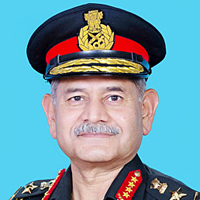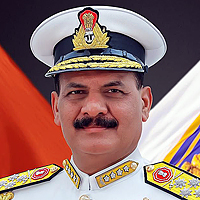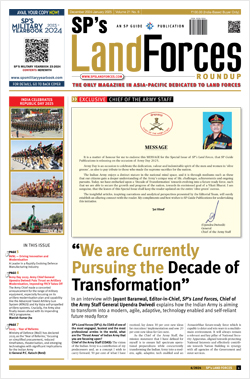INDIAN ARMED FORCES CHIEFS ON OUR RELENTLESS AND FOCUSED PUBLISHING EFFORTS

The insightful articles, inspiring narrations and analytical perspectives presented by the Editorial Team, establish an alluring connect with the reader. My compliments and best wishes to SP Guide Publications.

"Over the past 60 years, the growth of SP Guide Publications has mirrored the rising stature of Indian Navy. Its well-researched and informative magazines on Defence and Aerospace sector have served to shape an educated opinion of our military personnel, policy makers and the public alike. I wish SP's Publication team continued success, fair winds and following seas in all future endeavour!"

Since, its inception in 1964, SP Guide Publications has consistently demonstrated commitment to high-quality journalism in the aerospace and defence sectors, earning a well-deserved reputation as Asia's largest media house in this domain. I wish SP Guide Publications continued success in its pursuit of excellence.
- The layered Air Defence systems that worked superbly, the key element of Operation Sindoor
- Operation Sindoor | Day 2 DGMOs Briefing
- Operation Sindoor: Resolute yet Restrained
- India's Operation Sindoor Sends a Clear Message to Terror and the World – ‘ZERO TOLERANCE’
- Japan and India set forth a defence cooperation consultancy framework, talks on tank and jet engines
- Lt General Pratik Sharma takes over Command of Indian Army's Northern Command
- Major General Lisamma P.V. assumes the appointment of ADG, MNS
- Uzbekistan's progressive transformation is a bright spot in Central Asia; boosts cultural ties with India
- Terrorist Attack in Pahalgam in Kashmir: Unfolding a long surgical war against PAK
China Showcases Trans-Regional Mobility

The two-month long manoeuvres witnessed approximately four divisions, or 50,000 troops, of the People’s Liberation Army criss-crossing the country
On the eve of its 60th anniversary on October 1, 2009 the People’s Republic of China opted yet again to showcase its military prowess to the world. China’s largest ever military exercise Stride 2009 (Kuayue) was employed as a means to issue a clear message that the Chinese armed forces have come a long way from being a rustic and bucolic ‘Red Army’ that waged a ‘People’s War’ six decades ago. The People’s Liberation Army (PLA) put on display its most modern equipment. Its units flaunted innovative methods to deploy, operate and sustain the mix of old and new equipment that is now held by operational formations.
In what could be described as a belliger-ent showcasing of military capabilities and consequent willingness to use them, the PLA tested its prowess by undertaking the Stride 2009 exercises, which commenced on August 12, 2009 and continued for two months. The Chinese press reported these exercises as the PLA’s “largest-ever tactical event, in which they will be mobilised and transported vast distances across the nation”. The two-month long manoeuvres witnessed approximately four PLA divisions (50,000 troops) criss-crossing the country represent-ing as many as four Chinese Military Regions (MRs), including Lanzhou, Shenyang, Jinan and Guangzhou. The exercises principally were ground operations although the PLA Air Force provided the necessary support in moving troops and providing air cover.
Multiple mission scenarios
The aim of these manoeuvres was to test and practice ‘trans-regional mobility’ that focuses on moving field formations within China from one of its seven MRs to another. The exercise focused on implementing the 2007 Training Outline for informationised training and included multiple mission sce-narios—amphibious landing, air assault, close air support—under complex electro-magnetic environments. The Chinese press extensively reported PLA’s multi-mode move-ments by ground, rail (including high speed trains), water and/or air. China’s neighbours watched carefully as the trans-regional mobility experience could well be used out-side China’s borders, especially if neighbour-ing countries permit movement of PLA units through or over their territory.
For the past two decades, it has been well known that the Chinese held substantial drills every year in what was projected as experiments in capacity-building in the event that it became necessary to use force to settle the Taiwan dispute. However, the Kuayue exercises indicate a major transfor-mation in the pattern. For the first time, these were not directed at rehearsing an amphibious assault on Taiwan, but instead centre on the South China Sea. It may be recalled that a perpetual source of inter-state tensions between the Southeast Asian nations and China have been territorial dis-putes over islands in the South China Sea.
The Stride 2009 exercises are in line with what was proclaimed in the Chinese 2006 White Paper on National Defence. It expressed clear Chinese aspirations to seek world power status. Towards this end, the first target to be achieved was the creation of a modern force capable of defeating a moderate-sized adversary—namely Taiwan, Vietnam or India by 2010. Therefore, overt deployments and large-scale military manoeuvres are, in fact, a pointer to the Chinese resolve to back diplo-macy with the use of military force to solve outstanding disputes.
Training for integrated operations
China’s latest 2008 White Paper on National Defence foreshadowed the renewed emphasis on ground force training observed in Stride 2009. There were clear indications that the Chinese armed forces were training for “integrated joint operations” on future battlefields, in line with the strategic require-ments of high mobility operations and three-dimensional assault. There has been a perceptible shift in the PLA’s posture from regional defence to trans-regional mobility. It is gradually making its units small, modu-lar and multi-functional in organisation through appropriate downsizing and struc-tural reform. While accelerating the devel-opment of aviation, light mechanised and information counter-measure forces, it is giving priority to the development of tactical missiles, surface-to-air missiles and special operations forces, so as to increase its capa-bilities for land-air integrated operations, long-distance manoeuvres, rapid assault and special operations.
Soon after Stride 2009 was completed, the PLA Air Force’s 15th Airborne Corps conducted a similar 20-day, large-scale, multi-modal transportation, trans-regional exercise called Airborne Movement 2009 (Kongjiang Jidong), beginning mid-October 2009. The Airborne Movement 2009 paralleled the tasks that army divisions performed during Stride 2009. More than 13,000 troops were airlifted and began marching through Hubei, Henan, Anhui, and Jiangsu provinces. Heavy equipment, including ZBD-03 Airborne Fighting Vehicles, which were seen in the October 1 parade, was transported by rail while other personnel moved by road convoys to the exercise area in central China. The official Chinese Xinhua news agency reported the event as the “largest-ever Chinese airborne force trans-regional campaign mobility (sic) comprehensive training exercise”.





